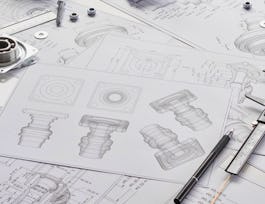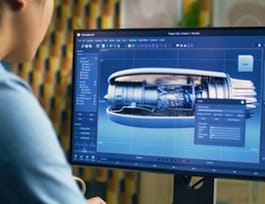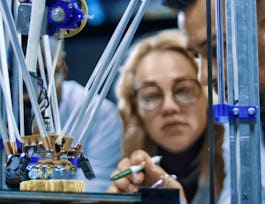Hello, everyone! Welcome to this course on Adding Electronics to Rapid Prototypes. This is part of the Rapid Prototyping and Tooling specialization. In this course, I’ll cover the basics of electric circuits, breadboards, and multimeters. I’ll then discuss different options for connecting electrical components as well as discuss different types of motors and actuators. Finally, I’ll end this course by discussing microcontrollers and how to use them to make even more sophisticated prototypes.



Adding Electronics to Rapid Prototypes
This course is part of Rapid Prototyping and Tooling Specialization

Instructor: Daniel Frank
Sponsored by Taipei Medical University [C4CB]
(10 reviews)
Recommended experience
What you'll learn
You will learn how to incorporate electronic components in your rapid prototypes.
Details to know

Add to your LinkedIn profile
9 assignments
See how employees at top companies are mastering in-demand skills

Build your subject-matter expertise
- Learn new concepts from industry experts
- Gain a foundational understanding of a subject or tool
- Develop job-relevant skills with hands-on projects
- Earn a shareable career certificate


Earn a career certificate
Add this credential to your LinkedIn profile, resume, or CV
Share it on social media and in your performance review

There are 5 modules in this course
Hello, everyone! Welcome to this course on Adding Electronics to Rapid Prototypes. This is part of the Rapid Prototyping and Tooling specialization. In this course, I’ll cover the basics of electric circuits, breadboards, and multimeters. I’ll then discuss different options for connecting electrical components as well as discuss different types of motors and actuators. Finally, I’ll end this course by discussing microcontrollers and how to use them to make even more sophisticated prototypes. By exploring both electrical simulations and many examples from different robotics projects I’ve had the opportunity to work on, by the end of this course, you should have a better understanding of the basics of electronics and how to add them to your designs to create high-quality prototypes. We have a lot of great content to cover, so without further ado, let’s dive into the world of rapid prototyping!
What's included
3 videos2 readings
In this module, you will learn about the basics of electric circuits, breadboards, and multimeters.
What's included
6 videos2 assignments
In this module, you will learn about different options for connecting electrical components.
What's included
2 videos2 assignments
In this module, you will learn about different types of actuators and how to select and control a DC motor.
What's included
6 videos2 assignments
In this module, you will learn about microcontrollers and how to use them to make sophisticated prototypes.
What's included
3 videos3 assignments
Instructor

Offered by
Why people choose Coursera for their career




Learner reviews
10 reviews
- 5 stars
80%
- 4 stars
20%
- 3 stars
0%
- 2 stars
0%
- 1 star
0%
Showing 3 of 10
Reviewed on Sep 9, 2023
this course is the basics of adding a electronics to the actual prototype. A basis introduction to microcontroller and arduino, their pins and the basics of programming.
Recommended if you're interested in Physical Science and Engineering

Arizona State University

Arizona State University

Arizona State University

Arizona State University

Open new doors with Coursera Plus
Unlimited access to 10,000+ world-class courses, hands-on projects, and job-ready certificate programs - all included in your subscription
Advance your career with an online degree
Earn a degree from world-class universities - 100% online
Join over 3,400 global companies that choose Coursera for Business
Upskill your employees to excel in the digital economy

